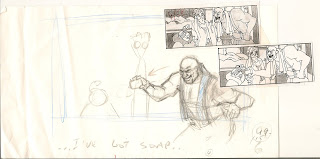
Directors Kirk Wise and Gary Trousdale issue the first scenes of Dr Sweet... After meeting with them and hearing their input as to how they envision the sequence, I'm ready to start.
Dr. Joshua Sweet...
The first time the audience is introduced to the Doctor we get all his vital information:
His stature: an upshot from Milo's point of view (pov) to accentuate his height...
His voice : deep, smooth, rich tone and rapid delivery of lines...
His thought process: quick brain process as he evaluates the situation that got Moliere upset...
His personality: humorous, peacemaker (Milo/Moliere), father figure (scolding Moliere), proud of his tools (bone saw) jokester (beakers) and at the same time the audience gets information about Moliere's quirkiness...

Workbook sketches and thumbnail sketches prior to animation...
The workbook (WB) sketch gives the animator basic information- camera angle, background, character size in relation to camera field size, camera move(s) if any, and other information the animator may need to know to bring to life a successful scene.
In this sequence...
Milo is ushered by Moliere into this mountain of a man...
The WB gives his ending pose from Milo's pov, the animator must figure how he got there (ending pose).
I started with the head in the up position with the dialogue "Uh, oh.." ending in the WB pose... "sat in the dirt, didn't you"...
Thumbnails to work out the action for the dialogue "...Moliere...what did I tell you about playing nice with the other kids?..." Tony DeRosa (Moliere) and John Pomeroy (Milo) would be responsible for the animation of the other characters.
WB/thumbnails...
"...I got soap..."
WB/thumbnails...
"...and I'm not afraid to use it..."
WB/thumbnails...
Thumbs to work out action of the towel snap...
Exposure sheet (X-sheet)-
In written form it gives the animator information about the scene:
A synopsis, scene length, starting and ending field sizes and camera moves.
There are columns for character(s), overlay, underlay, background and effects.
A column marked DIAL is for dialogue in which words are broken down into the syllables just as the voice actor said them and how much time between the words spoken.
I used the third column from the left to pose out small drawings to get a rough idea of the timing of the action.
(Under this old system, in my era, there were limits to the number of 'cels' in a scene before the bottom levels were out of focus. With the elimination of cels, any number of levels can be compiled in a computer without compromising the quality or color of the final product.)
until next time...












Remarkable as always this made my day! I feel blessed to witness this from the authentic. God is good
ReplyDeleteHi Ron,
ReplyDeletethanks so much for another inspiring breakdown.
It was great to read your analysis of the character and the scene.
The thumbnails are clear and entertaining, 'pure gold.